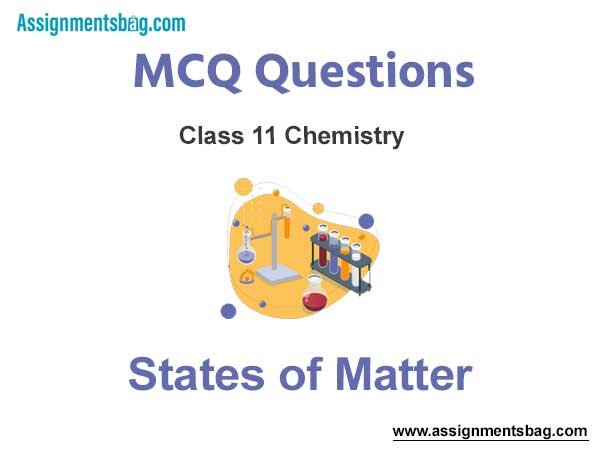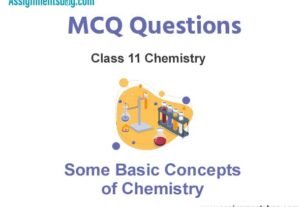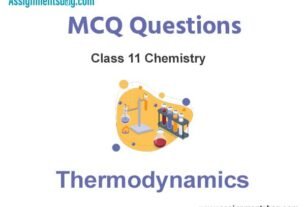Please refer to MCQ Questions Chapter 5 States of Matter Class 11 Chemistry with answers provided below. These multiple-choice questions have been developed based on the latest NCERT book for class 11 Chemistry issued for the current academic year. We have provided MCQ Questions for Class 11 Chemistry for all chapters on our website. Students should learn the objective based questions for Chapter 5 States of Matter in Class 11 Chemistry provided below to get more marks in exams.
Chapter 5 States of Matter MCQ Questions
Please refer to the following Chapter 5 States of Matter MCQ Questions Class 11 Chemistry with solutions for all important topics in the chapter.
MCQ Questions Answers for Chapter 5 States of Matter Class 11 Chemistry
Question. van der Waals’ equation for n moles of a gas is
(a) (P + n2a/v2) (v – nb)= RT
(b) (P + na/v2) (v – nb)= RT
(c) (P + a/v2) (v – b)= RT
(d) (P + n2a/v2) (v – b)= RT
Answer
A
Question. The compressibility factor for a real gas at high pressure is
(a) l + RT/pb
(b) l
(c) l + pb/RT
(d) l – pb/RT
Answer
C
Question. One mole of oxygen at 273 Kand one mole of sulphur dioxide at 546 K are taken in two separate containers, then
(a) kinetic energy of O2 > kinetic energy of SO2
(b) kinetic energy of O2 < kinetic energy of SO2
(c) kinetic energy ofboth are equal
(d) None of the above
Answer
B
Question. If the temperature of 500 mL of air increases from 27°C to 42°C under constant pressure, then the increases in volume shall be
(a) 15 mL
(b) 20 mL
(c) 25 mL
(d) 30 mL
Answer
C
Question. NH3 and HCI gas are introduced simultaneously from the two ends of a long tube. A white ring of NH4Cl appears first
(a) nearer to the HCl end
(b) at the centre of the tube
(c) throughout the tube
(d) nearer to the NH3 end
Answer
A
Question. For an ideal gas, number of mol per litre in terms of its pressure p, temperature T and gas constant R is
(a) pT/R
(b) pRT
(c) p /RT
(d) RT/p
Answer
C
Question. Therms velocity of an ideal gas at constant pressure varies with density (d) as
(a) 1/✓d
(b) d
(c) ✓d
(d) d2
Answer
A
Question. Which of the following represents total kinetic energy of one mole of gas?
(a) 1/ 2RT
(b) 3/ 2RT
(c) (Cp-Cv)RT
(d) 2/3RT
Answer
B
Question. For gaseous stage, if most probable speed is denoted by C*, average speed by C– and root square speed by C, then for a large number of molecules, the ratios of these speeds are
(a) C*: C– : C = 1.225 : 1.128: 1
(b) C* :C– :C= 1.128 : 1.1225: 1
(c) C* :C– :C= 1: 1.128: 1.225
(d) C* :C– :C= 1: 1.225: 1.128
Answer
C
Question. At 400 K, the root mean square (rms) speed of a gas X (molecular weight = 40) is equal to the most p robable speed of gas Y at 60 K. The molecular weight of the gas Y is
(a) 2
(b) 4
(c) 6
(d) 8
Answer
B
Question. The rms speed of hydrogen is ✓7 times the rms speed of nitrogen. If T is the temperature of the gas, then
(a) TH2 = TN2
(b) TH2 > TN2
(c) TH2 < TN2
(d) TH2 = √7TN2
Answer
C
Question. Therms velocity of molecules of a gas of density 4 kg m-3 and pressure 1.2 x 105 nm-2 is
(a) 300 ms-1
(b) 900 ms-1
(c) 120 ms-1
(d) 600 ms-1
Answer
A
Question. In the equation of state ofan ideal gas pV = nRT ,the value of the universal gas constant would depend only on
(a) the nature of the gas
(b) the pressure of the gas
(c) the units of the measurement
(d) None of the above
Answer
C
Question. Different gases at the same temperature have same
(a) pressure
(b) number of moles
(c) volume
(d) average kinetic energy
Answer
D
Question. Vapour pressure increases with increase in
(a) concentration of solution containing non-volatile solute
(b) temperature upto boiling point
(c) temperature upto triple point
(d) altitude of the concerned place of boiling
Answer
B
Question. Kinetic energy of one mole of an ideal gas at 300 K (in kJ) is
(a) 3.74
(b) 348
(c) 34.8
(d) 3.48
Answer
A
Question. The kinetic theory of gases preclicts that total kinetic energy of a gaseous assembly depends on
(a) pressure of the gas
(b) temperature of the gas
(c) volwne of the gas
(d) pressure, volume and temperature of the gas
Answer
B
Question. If temperature of 1 mole of gas is increased by 50°C, then calculate the change in kinetic energy of the system.
(a) 623.25 J
(b) 6.235 J
(c) 623.5 J
(d) 6235.0 J
Answer
A
Question. The average velocity (in cm/s) of hydrogen molecule at 27°C will be
(a) 19.3 x 104
(b) 17.8 x 104
(c) 24.93 x 109
(d) 17.8 x 108
Answer
B
Question. Two gas cylinders having san1e capacity have been filled with 44 g of H2 and 44 g of CO2 respectively. If the pressure in CO2 cylinder is 1 atrn at a particular temperatw·e, then the pressure in the hydrogen cylinder at the same temperature is
(a) 2 atm
(b) 1 atrn
(c) 22 atm
(d) 44 atrn
Answer
C
Question. In the van der Waals’ equation given below,
[p + a(n / V)2](V – nb)= nRT, the a (n / V)2 and – nb
terms represent respectively, corrections for
(a) derivations in the pressure and the temperature
(b) intermolecular attractive forces and molecular volwnes
(c) intermolecular attractive forces and inelastic collisions
(d) intermolecular repulsive forces and high temperatures
Answer
B
Question. The temperature 30.98°C is called critical temperature (Tc) of carbon dioxide. The critical temperature is the
(a) lowest temperature at which liquid carbon dioxide is observed
(b) highest temperature at which gas carbon dioxide is observed
(c) highest temperature at which solid carbon dioxide is observed
(d) highest temperature at which liquid carbon dioxide is observed
Answer
D
Question. At the same temperature, calculate the ratio of average velocity of SO2 to CH4 . CAMUJ
(a) 2 : 3
(b) 3 : 4
(c) 1 : 2
(d) 1 : 6
Answer
C
Question. In two vessels of 1 L each at the same temperature 1 g of H2 and 1 g of CH4 are taken, for these
(a) Vrms values will be same
(b) kinetic energy per mole will be same
(c) total kinetic energy will be same
(d) pressure will be same
Answer
B
Question. As the temperature is raised from 20°C to 40°C, the average kinetic energy of neon atoms changes by a factor of which of the following?
(a) 1/2
(b) √313/ 293
(c) 313/293
(d) 2
Answer
C
Question. Based on kinetic theory of gases following laws can be proved
(a) Boyle’s law
(b) Charles’ law
(c) Avogadro’s law
(d) All of these
Answer
D
Question. If Z is a compressibility factor, van der Waals’ equation at low pressure can be written as
(a) Z = 1+ RT/pb
(b) Z = 1 – a/VRT
(c) Z = 1 – pb/RT
(d) Z = 1 + pb/RT
Answer
B
Question. Find the pressure ofa sample of CCI4 , if 1.0 mole occupies 35 L at 77°C. Assume CCI4 obeys the van der Waals equation of state. ( a = 20 L2 mol-2 atm and b = 0.14 L mol-1)
(a) 0.56 atrn
(b) 0.572 atrn
(c) 0.82 atm
(d) 0.807 atrn
Answer
D
Question. The compressibility factor (Z) of one mole of a van der Waals’ gas ofnegligible ‘a’ value is
(a) 1
(b) bp/RT
(c) 1 + bp/RT
(d) 1 – bp/RT
Answer
C
Question. a and bare van der Waals’ constants for gases. Chlorine is more easily liquefied than ethane because
(a) a and b for Cl2 > a and b for C2H6
(b) a and b for Cl2 < a and b for C2H6
(c) a for Cl2 > a for C2H6 but b for Cl2 > b for C2H6
(d) a for Cl2 > a for C2H6 but b for Cl2 < b for C2H6
Answer
D
Question. The te1m that corrects for the attractive forces present in a real gas in the van der Waal’s equation is
(a) nb
(b) n2a/ V2
(c) -(n2a/V2)
(d) – nb
Answer
B
Question. Pressure exerted by 1 mole of methane in a 0.25 L container at 300 K using van der Waals’ equation is (given, a= 2.253 atm L2 mol-2 ,b= 0.0428 L mol-1)
(a) 82.82atm
(b) 152.5latm
(c) 190.52 atm
(d) 70.52 atm
Answer
A
Question. When a sample of gas is compressed at constant temperature from 15 atm to 6 atm, its volume changes from 76 cm3 to 20.5 cm3 . Which of the following statements are possible explanations of this behaviour?
I. The gas behaves non-ideally.
II. The gas dimerises.
III. The gas is absorbed into the vessel walls.
(a) I, II and III
(b) I and II only
(c) II and III
(d) Only I
Answer
D
Question. The following is a method to determine the swface tension of liquids
(a) single capillary method
(b) refractometric method
(c) polarimetric method
(d) boiling point method
Answer
A
Question. What is the temperature at which the kinetic energy of 0.3 mole of helium is equal to the kinetic energy of 0.4 mole of argon at 400 K?
(a) 400 K
(b) 873 K
(c) 533 K
(d) 300 K
Answer
C
Question. Under which of the following conditions, van der Waals’ gas approaches ideal behaviour?
(a) Extremely low pressure
(b) Low temperature
(c) High pressure
(d) Low product of pV
Answer
A
Question. The units of van der Waals’ constants a, b respectively, are
(a) L atm2 mol-1 t and mol L-1
(b) L atm mol-1 t and mol L-1
(c) L-2 atm mol-2 and mol L-1
(d) L-2 atm-1 mol-1 and mol L-2
Answer
C
Question. Which factors do not affect the vapour pressure ofa liquid at equilibrium?
I. Intermolecular forces of attraction.
II. The volume of liquid present.
III. The temperanire of the liquid.
(a) Only I
(b) Only II
(c) I and II
(d) II and III
Answer
B
Question. Which of the following is correct at freezing point?
(a) Solid and liquid are in equilibrium
(b) Solid and liquid are not in equilibrium
(c) Vapour pressure of liquid is greater than solid
d) None of the above
Answer
A
Question. Cooking is fast in a pressure cooker, because
(a) food particles are effectively smashed
(b) water boils at higher temperature inside pressure cooker
(c) food is cooked at constant volume
(d) loss of heat due to radiation is minimum
Answer
B
Question. Which of the following will increase with the increase in temperature?
(a) Surface tension
(b) Viscosity
(c) Molality
(d) Vapour pressure
Answer
D
Question. A gas deviates from ideal behaviow· at a high pressure because its molecules
(a) attract one another
(b) show the Tyndal effect
(c) have kinetic energy
(d) are bound by covalent bonds
Answer
A
Question. Positive deviation from ideal behaviour takes place because of
(a) molecular interaction between atom and pV/nRT > I
(b) molecular interaction between atom and pV/nRT < I
(c) finite size of atoms and PV/nRT > I
(d) finite size of atoms and PV/nRT < I
Answer
C
Question. The temperature, at which a gas shows maximum ideal behaviour, is known as
(a) Boyle’s temperature
(b) inversion temperature
(c) critical temperature
(d) absolute temperature
Answer
A
Question. The CO2 gas does not follow gaseous laws at all ranges of pressure and temperature because
(a) it is triatomic gas
(b) its internal energy is quite high
(c) there is attraction between its molecules
(d) it solidify at low temperature
Answer
C
Question. The compressibility factor of an ideal gas is
(a) 1
(b) 2
(c) 4
(d) 0
Answer
A
Question. Surface tension vanishes at
(a) boiling point
(b) critical point
(d) triple point
(c) condensation point
Answer
B

We hope you liked the above provided MCQ Questions Chapter 5 States of Matter Class 11 Chemistry with solutions. If you have any questions please ask us in the comments box below.


